Ever wonder why some donation forms consistently outperform others? The answer lies not in fancy designs or complex features, but in fundamental human psychology.
I’ve learnt that understanding the psychological triggers that drive giving can transform an average donation form into a powerful fundraising tool. Over the years, I’ve discovered that small, psychology-based changes can make a huge difference in how people respond to giving opportunities. These aren’t manipulative tactics – they’re proven principles that help connect donors with causes they care about.
In this guide, we’ll explore seven psychological triggers that can significantly boost your donation form’s conversion rate. These insights come from analyzing thousands of successful nonprofit campaigns and are backed by behavioral science research.
Think of these triggers as building blocks of donor engagement. When implemented thoughtfully, they can help you:
- Build stronger connections with potential donors
- Increase average donation amounts
- Improve recurring donation sign-ups
- Reduce form abandonment rates
Sounds good? Let’s dive into these proven psychological triggers and learn how to implement them in your donation forms.
If you haven’t created your donation form yet, learn how to do that in our video tutorial:
What’s In This Guide?
- Why Donation Form Psychology Matters
- 1. Social Proof: Show Donors They're Not Alone
- 2. Urgency and Scarcity: Motivate Action Now
- 3. Impact Visualization: Make Giving Tangible
- 4. Smart Defaults: Guide Without Pushing
- 5. Emotional Connection: Tell Stories That Matter
- 6. Reciprocity: Give First to Receive
- 7. The IKEA Effect
- How Charitable Makes Psychology-Based Fundraising Simple
- Frequently Asked Questions
Why Donation Form Psychology Matters
Think about the last time you made a donation online. Was it a quick, impulsive decision, or did you pause and think it through? Most likely, it was a mix of both – your heart telling you to help, while your mind processed the practical details.
Understanding this interplay between emotion and reason is crucial for creating donation forms that work. It’s not just about having a form that functions; it’s about creating an experience that connects with donors at both levels.
The Science of Giving (Without the Jargon)
When someone lands on your donation form, they’re usually already interested in your cause. But something interesting happens in those crucial moments before they click “donate.” Their brain is rapidly processing questions like: Is this the right amount? Will my donation actually help? Can I trust this organization? Will this fit my budget? Have I already donated this month?
Modern donation forms that convert well aren’t just collecting information – they’re answering these unspoken questions naturally and reassuringly. They guide donors through this decision-making process in a way that feels comfortable and confident.
Small Changes, Big Results
Here’s what’s fascinating: tiny adjustments to your donation form can have surprising impacts. One nonprofit we worked with increased their conversion rate by 28% just by changing how they presented donation amounts, the Pay Now button, and their impact descriptions.
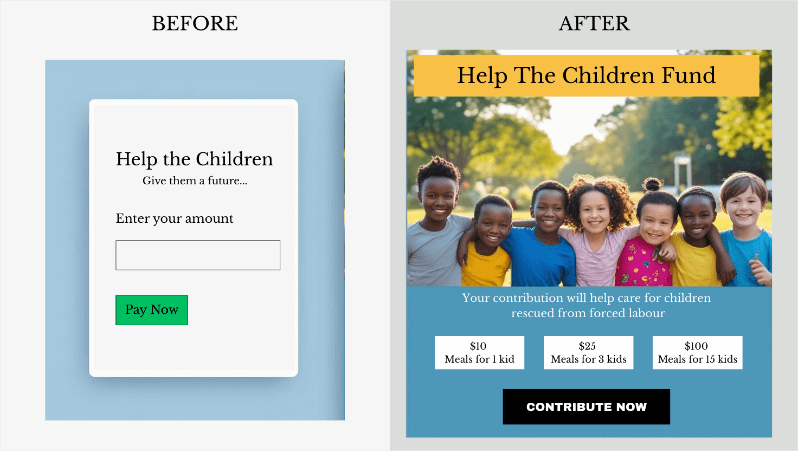
These aren’t complicated changes. They’re simple tweaks that align with how people naturally think and make decisions. Things like:
- Showing exactly what different donation amounts can achieve
- Adding a brief story about someone who’s been helped
- Including a simple message about how many people donated this month
If you haven’t created a fundraiser campaign before, learn how to do that with our easy video tutorial:
With more giving happening online than ever before, understanding these psychological triggers isn’t just helpful – it’s essential. Your donation form might be the only interaction a potential donor has with your organization. Making it work better isn’t about manipulation; it’s about making it easier for people to act on their generous intentions.
How would you know if your changes are helping improve conversions? That’s easy. With a donation plugin like Charitable, you’ll get readymade fundraising reports that give you valuable insights into your campaigns’ performance, funds raised, payment methods, donor trends, and more.
Now, in the following sections, we’ll look at seven specific psychological triggers and exactly how to use them. Each one is backed by real-world examples and practical tips you can implement right away.
Ready to discover the first trigger? Let’s dive into how social proof can transform your donation form.
1. Social Proof: Show Donors They’re Not Alone
We’ve all been there – we chose the crowded restaurant because it signalled that the food was good. So many people trusted this place. We ignored the empty restaurant cause we assumed it wasn’t good. That’s why people weren’t going there.
The busy one is usually the most appealing one to the vast majority of people. That’s social proof in action, and it works just as powerfully on donation forms.
Social proof isn’t about pressure – it’s about reassurance. When donors see that others are supporting your cause, it validates their own desire to help. It’s like a friendly nod saying, “Yes, you’re making a good choice.”
The key is to add social proof naturally. Think of it as sharing good news rather than showing off. Here are some ways that work particularly well:
Allow donors to leave comments when they donate. These act as personal testimonies such as:
“I started donating last year, and it’s been amazing to see how my small gift makes a big difference.” — Amanda R., monthly donor
Personal stories from other donors create emotional resonance and trust.
Simple Counter “Join 1,247 donors who’ve supported clean water projects this year”
This works because it’s specific and current. Vague numbers like “thousands of donors” don’t have the same impact as precise figures.
Real-Time Activity “Sandra from Portland just provided 50 meals”
These live donor feeds can be powerful, but use them carefully. They work best when your organization has regular donation activity.

You could also add a line like this to your form: “Every month, over 400 people like you help us protect local wildlife. Most give between $25-75.”

You can use a tool like TrustPulse to automate this on your website. It will track donation activity and create and display non-intrusive popups on your site that show recent activity and contributions.
One thing to keep in mind, don’t fall into the trap of fake urgency or inflated numbers. Phrases like “Thousands are donating right now!” can feel manipulative and damage trust. Authentic social proof is always more effective.
Next up, we’ll look at how creating a sense of urgency can motivate action without pushing too hard.
2. Urgency and Scarcity: Motivate Action Now
We’re all familiar with that little nudge we feel when we see “Only 2 seats left!” while booking a flight. It works because it’s real – those seats really are limited. The same principle can work ethically and effectively with donation forms.
The key is creating genuine urgency without resorting to pressure tactics. Your donors are smart people who want to help – they just sometimes need a gentle reminder about why acting now matters.
For instance, matching gift campaigns create natural urgency: “Every dollar you give before midnight will be doubled by our sponsor.” This works because it’s both true and time-sensitive – donors understand they can make twice the impact by acting now.

Here’s how some organizations create authentic urgency:
“We need to raise 5,000 by Friday to secure winter shelter space. We′re currently at 3,750.”
This works because it’s specific, time-bound, and shows clear progress. Donors can see exactly how their gift helps reach a concrete goal.
Holiday giving campaigns offer another natural opportunity: “Help us provide 1,000 holiday meals by December 20th. We’re 80% there!”
Some practical ways to implement this:
- Use a simple progress bar that shows how close you are to your goal. People love to help complete something that’s already well underway.
- Add a countdown timer for matching gift periods or end-of-year campaigns. Just make sure it’s for a real deadline.
You can use tools like Charitable to easily add these features to your donation forms. Most of the templates already have progress bars added. You can also quickly drag and drop the progress bar to your campaign.
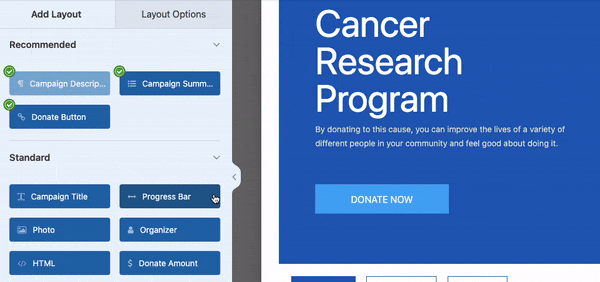
Learn how to add a fundraising thermometer or progress bar to your donation campaigns here: Progress Bar Blog Tutorial » | Progress Bar Video Tutorial »
Remember, the goal isn’t to create false pressure. Instead, help donors understand why timing matters for your cause. When you’re transparent about real deadlines and needs, donors appreciate knowing how they can make the biggest impact.
3. Impact Visualization: Make Giving Tangible
Ever noticed how a powerful image or video can move you more than any words? That’s what makes visual impact so crucial on donation forms. Instead of just telling donors about their impact, show them.
Share authentic moments that bring your cause to life. A short video of a recently built water well, a before-and-after photo gallery of your animal rescue work, or real-time updates from your food bank can transform abstract donations into visible change.
Inside the Charitable campaign builder, you can simply click a button to add your own image or video to bring your campaign to life.
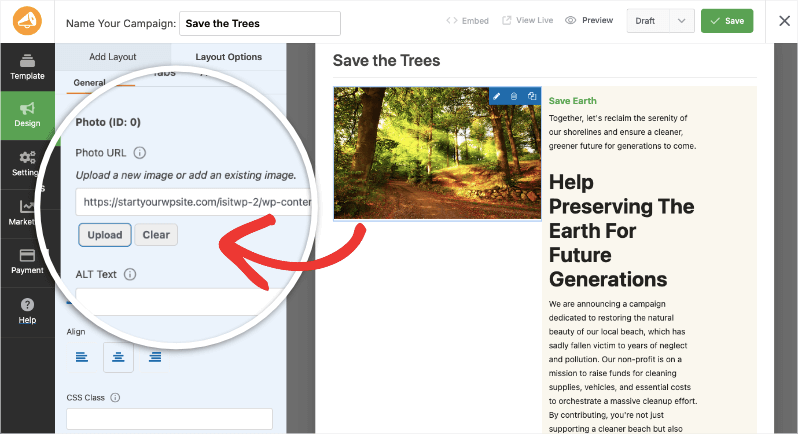
Here are effective ways organizations are doing this:
Link your latest impact report right on the form: “See how last month’s donations provided shelter for 127 families”
Add a compact photo gallery showing:
- Today’s meal delivery to seniors
- Last week’s after-school program
- Recent community garden harvest
Include a 30-second video snippet: “Watch how your donation transforms our local shelter”
Many organizations create an immediate connection through:
- Instagram feed integration showing daily impact
- Virtual tours of their facilities
- Interactive maps of communities they’ve helped
You can easily embed visual content without slowing down your form. You can showcase impact while keeping the donation process smooth and fast.
Important tip: Keep visuals authentic and recent. Real photos of your actual work beat stock images every time. Use a stunning website theme and update your visual content regularly to show ongoing impact.
4. Smart Defaults: Guide Without Pushing
Think about the last time you purchased something online. Did you stick with the default shipping option? Most people do. Smart defaults work because they help people make decisions quickly while still leaving them in control.
When it comes to donation forms, thoughtful default options can guide donors toward comfortable giving levels without making them feel pressured. It’s about making the process easier, not manipulative.
For example, instead of an empty box asking “How much would you like to donate?” offer pre-selected amounts based on your donor data:
$25 $50 $100 $250 Custom Amount (With $50 pre-selected)
This works because it removes the guesswork. Donors don’t have to wonder what’s appropriate or typical – they can see a range of normal giving amounts while still having the freedom to choose their own.
Recurring donation defaults can be particularly effective where a box is already ticked for the donor that reads:
“Make this a monthly gift? ✓”

Research shows that when this box is pre-checked (where legally permitted), monthly giving participation increases by 35%.
Some organizations also use smart defaults for their donation forms based on previous giving history:
- First-time donors see standard amounts
- Returning donors see suggestions based on their last gift
- Major donors see higher default amounts
Always make it easy to change defaults. The goal is to help donors make confident decisions, not to lock them into preset choices.
5. Emotional Connection: Tell Stories That Matter
Stories have a high impact! A photo of a rescued puppy finding their forever home, or a letter from a student who finally got to attend college – these stories stick with us because they make causes real and personal.
On donation forms, the right story can transform a transaction into a meaningful moment. But here’s the key – it needs to be brief, authentic, and directly connected to the donation being made.
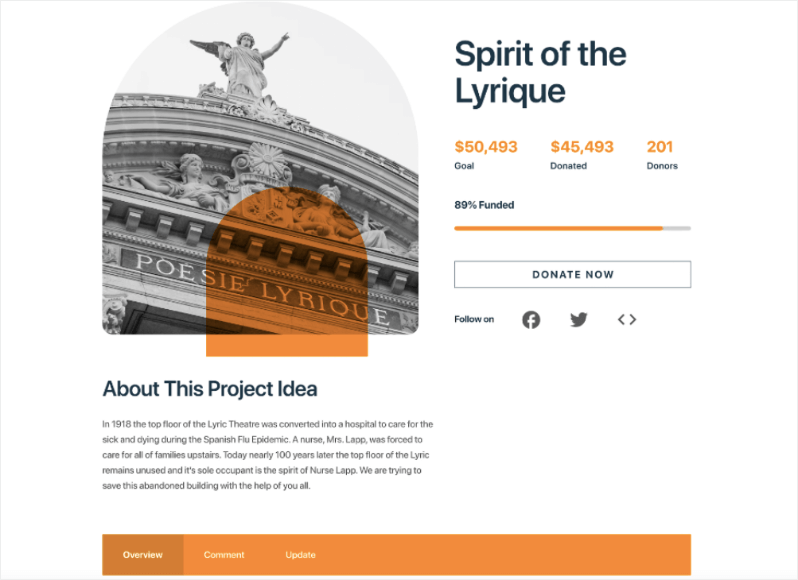
Here’s how some organizations do this effectively:
“Meet Sarah. She walks three miles each way to get clean water for her family. Your gift today helps build a well in her village.”
“Every shelter pet has a story. Max waited 247 days for a home. Your donation helps dogs like Max get the care they need while waiting for their forever family.”
The best stories on donation forms share three qualities:
- They’re specific (one person, one situation)
- They’re current (happening now)
- They connect directly to the donor’s gift
You can add these story elements to your form using simple text or, even better, a small photo with a caption. Many organizations rotate these stories monthly to keep content fresh and show ongoing impact.
Powerful storytelling doesn’t require long paragraphs. Sometimes a single line can create that emotional connection: “Your gift means a child like Tommy won’t go to bed hungry tonight.”
The goal isn’t to overwhelm donors with emotion, but to remind them of the real people and real impact behind their giving.
6. Reciprocity: Give First to Receive
Ever notice how a free sample at the grocery store makes you more likely to buy the product? That’s reciprocity in action – when someone gives us something, we naturally want to give back.
For donation forms, this doesn’t mean giving away physical items. Instead, it’s about providing value upfront that makes donors feel appreciated before they even give.
Here’s how successful organizations use reciprocity:
Instant Impact Reports “Download our 2024 Impact Report to see exactly how donations like yours changed lives this year”
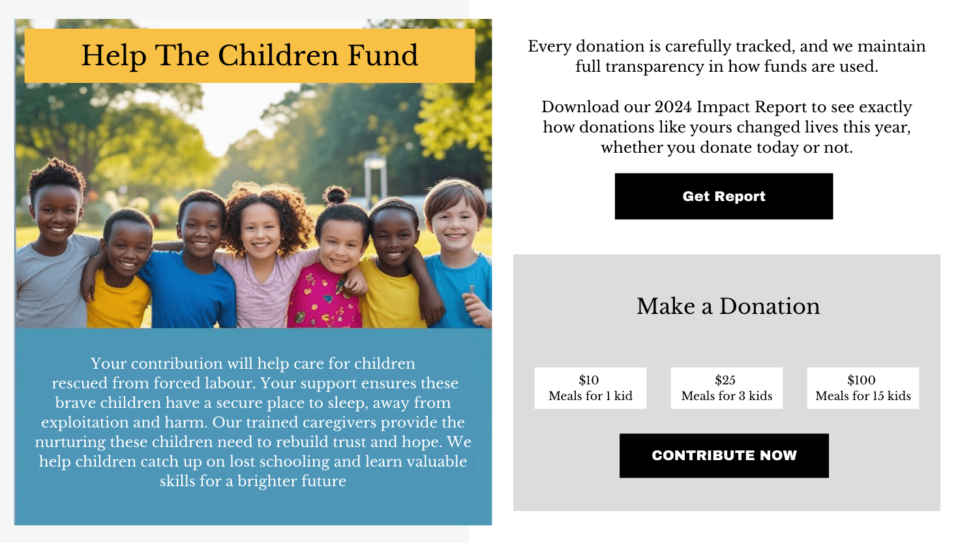
Free Resources “Get our free guide: ’10 Ways to Help Homeless Veterans in Your Community’ – whether you donate today or not”
Personal Thank You Videos “Watch a 30-second thank you from the kids at our after-school program” (shown before the donation ask)
Some effective reciprocity strategies:
- Offer a meaningful digital download (impact report, volunteer guide, or educational resource)
- Share exclusive content like behind-the-scenes videos or success stories
- Provide a “donation calculator” tool showing exactly what different amounts achieve
- Give donors a preview of the thank-you experience they’ll receive
The key is that these offerings should feel valuable, not like marketing materials. When you give donors something meaningful first, they’re more inclined to reciprocate with their support.
Example in action: “Before you decide to donate, we’d love to share our Season of Hope photo book – 20 stories of families you could help this winter. No donation required.”
This approach works because it:
- Shows confidence in your work
- Demonstrates transparency
- Creates a positive first interaction
- Makes donors feel valued from the start
Remember: The “gift” you provide should be genuinely useful or moving, not just a thinly-veiled donation request. When done right, reciprocity builds trust and connection that leads to more engaged, long-term donors.
7. The IKEA Effect
Ever assembled IKEA furniture? Remember that sense of pride when you stepped back and admired your handiwork? That’s the IKEA effect – we value things more when we participate in creating them. The same psychology applies to charitable giving.
When donors feel like active participants in building something meaningful rather than passive check-writers, they become emotionally invested in the outcome and more likely to give again.
Here are some ways you can put this into action:
“Build a Brighter Future with Us: Our new children’s shelter is 67% funded. Choose which room you’ll help complete:
- Kitchen (89% funded): Help us serve 300 meals daily – $75 remaining per appliance
- Library (45% funded): Stock shelves with books and hope – $50 per bookshelf section
- Playground (72% funded): Give kids space to be kids again – $100 per play structure component
Watch your contribution appear on our live shelter blueprint. You’ll receive photos when your specific area is complete!”
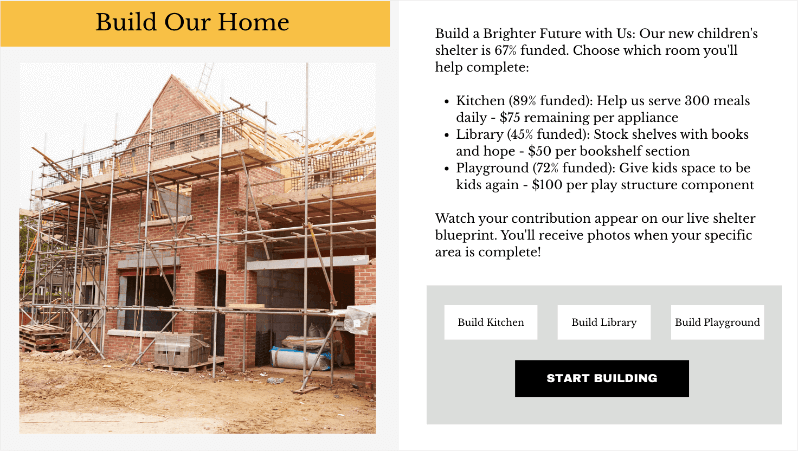
The key is making donors feel like essential architects of change, not just funders. When they help “build” the solution, they’re not just donating – they’re creating something meaningful that they’ll want to see through to completion.
Remember to use these ethically and authentically. The goal is to overcome psychological barriers to giving, not manipulate vulnerable people. The cause must always be genuine and the impact real.
The best donation forms feel natural, not manipulative. When these triggers work together smoothly, donors feel confident and inspired to give.
Quick Win To Try Today: Add one simple impact statement to your form. Something like “Your $40 gift provides a night of safe shelter.” That single line could be all it takes to help donors connect with your cause.
Remember, there’s no perfect formula. What works for one organization might not work for another. The key is to test, learn, and adjust based on your donors’ responses.
And finally, keep it real. Authentic communication always beats psychological tricks. These triggers work best when they help donors understand the genuine impact they can make.
Learn how to set up your donation campaign here »
How Charitable Makes Psychology-Based Fundraising Simple
Implementing these psychological triggers doesn’t require a psychology degree or coding skills. With Charitable, you can create campaigns optimized for donor psychology in just minutes – all with simple clicks, no code needed.
Built-In Psychology, Built-In Results
Charitable’s professionally designed templates already incorporate these proven triggers. Each template is crafted with donor psychology in mind, featuring:
- Progress bars that tap into the IKEA effect
- Suggested donation amounts using smart defaults
- Impact statements that make giving tangible
- Visual layouts designed to build emotional connection
Drag-and-Drop Your Way to Better Conversions
The intuitive campaign builder lets you add powerful psychological elements instantly:
- Enable donor comments for instant social proof – let supporters share why they gave
- Add recurring donation options with one click – pre-checked to boost monthly giving
- Include referral features that leverage social networks and peer influence
- Insert progress thermometers to create urgency and show momentum
- Upload images and videos to strengthen emotional connections
Everything You Need, Nothing You Don’t
No more wrestling with complex code or expensive developers. Whether you want to A/B test different psychological triggers or create matching gift campaigns with countdown timers, Charitable puts professional fundraising tools at your fingertips.
The best part? You can see exactly how these psychological principles boost your results with built-in analytics and reporting. Watch your conversion rates climb as you optimize based on real donor behavior.
Ready to Transform Your Fundraising?
Stop leaving donations on the table. Join thousands of nonprofits using Charitable to create high-converting campaigns that connect with donors on a deeper level.
Start Your Free Trial Today → No credit card required. Set up your first psychologically-optimized campaign in under 10 minutes.
Frequently Asked Questions
Are these psychological triggers manipulative?
Not at all. These triggers are about understanding how people naturally make decisions and removing barriers to giving. They help connect donors with causes they already care about. The key is using them ethically and authentically – your cause must be genuine and the impact real.
Will these techniques work for small nonprofits?
Absolutely! In fact, smaller organizations often see the biggest improvements because they’re starting from a more basic setup. You don’t need a big budget – many of these changes cost nothing to implement.
What if these triggers don’t work for my organization?
Every organization is unique. These are proven principles, but they need to be adapted to your specific donors and cause. Keep testing and adjusting until you find what resonates with your community.
How quickly will I see results?
Some changes show immediate impact. One nonprofit that uses Charitable saw a 28% increase in conversions just by adjusting donation amounts and impact descriptions. However, give each change at least 2-4 weeks to gather meaningful data. See our reports on real organizations: Match4Mission and EndParalysis.
Should I implement all seven triggers at once?
We receommend starting with one or two that feel most natural for your organization. Test them, measure results, then gradually add others. Too many changes at once can overwhelm donors and make it hard to know what’s working.
Which trigger should I start with?
Impact visualization is often the easiest quick win. Simply adding “Your $40 gift provides a night of safe shelter” can immediately improve conversions. Social proof and smart defaults are also relatively simple to implement.
How do I know if my changes are working?
Use analytics tools to track conversion rates, average donation amounts, and form abandonment rates. Plugins like Charitable provide readymade fundraising reports showing campaign performance, funds raised, and donor trends.
What if we don’t have enough donors for social proof?
Start small and be honest. “Join 12 caring neighbors who’ve already donated this month” is better than inflating numbers. You can also use other forms of social proof like volunteer hours or meals served.
How do I create urgency without being pushy?
Focus on real deadlines and genuine needs. Matching gift campaigns, seasonal needs, and specific project funding goals create natural urgency. Always be transparent about why timing matters.
What if I don’t have professional photos or videos?
Authentic smartphone photos of your actual work often perform better than stock images. Keep it real – a genuine photo of your team in action beats a polished but generic image every time.
Do these changes slow down my donation form?
When implemented correctly, they shouldn’t. Modern tools like Charitable allow you to add progress bars, images, and other elements without affecting load times. Always test your form’s speed after making changes.
Can I use these techniques on third-party donation platforms?
Many platforms allow customization of donation pages. Focus on the elements you can control – suggested amounts, impact statements, and form copy. Some triggers like social proof might require switching to a more flexible platform.
Do these triggers work on mobile devices?
Yes, but mobile optimization is crucial. Keep stories brief, images small, and forms simple. Test every change on mobile devices since over 50% of donations now come from smartphones.
What about donor privacy with social proof?
Always respect privacy. Use first names and last initials only, get permission for testimonials, and allow donors to give anonymously. Tools like TrustPulse can automate this while protecting donor information. Plus, Charitable’s comments feature allows donors to leave messages anonymously.
Should I A/B test different psychological triggers?
Yes, but thoughtfully. Test one element at a time and ensure both versions are ethical and honest. Track not just conversion rates but also donor satisfaction and retention.
I’m overwhelmed – where do I begin?
Start here:
- Add one impact statement to your form (e.g., “$50 provides 20 meals”)
- Include a progress bar if you have a specific goal
- Add a recent photo from your work
- Test for two weeks and measure results.
What if these triggers don’t work for my organization?
Every organization is unique. These are proven principles, but they need to be adapted to your specific donors and cause. Keep testing and adjusting until you find what resonates with your community.
Where can I learn more about donation form optimization?
Check out the resources mentioned in the article, including Charitable’s video tutorials and blog posts. Also, consider joining nonprofit marketing communities where organizations share what’s working for them.
Remember, every organization is unique. What works brilliantly for one nonprofit might fall flat for another. The key is to stay authentic to your mission.
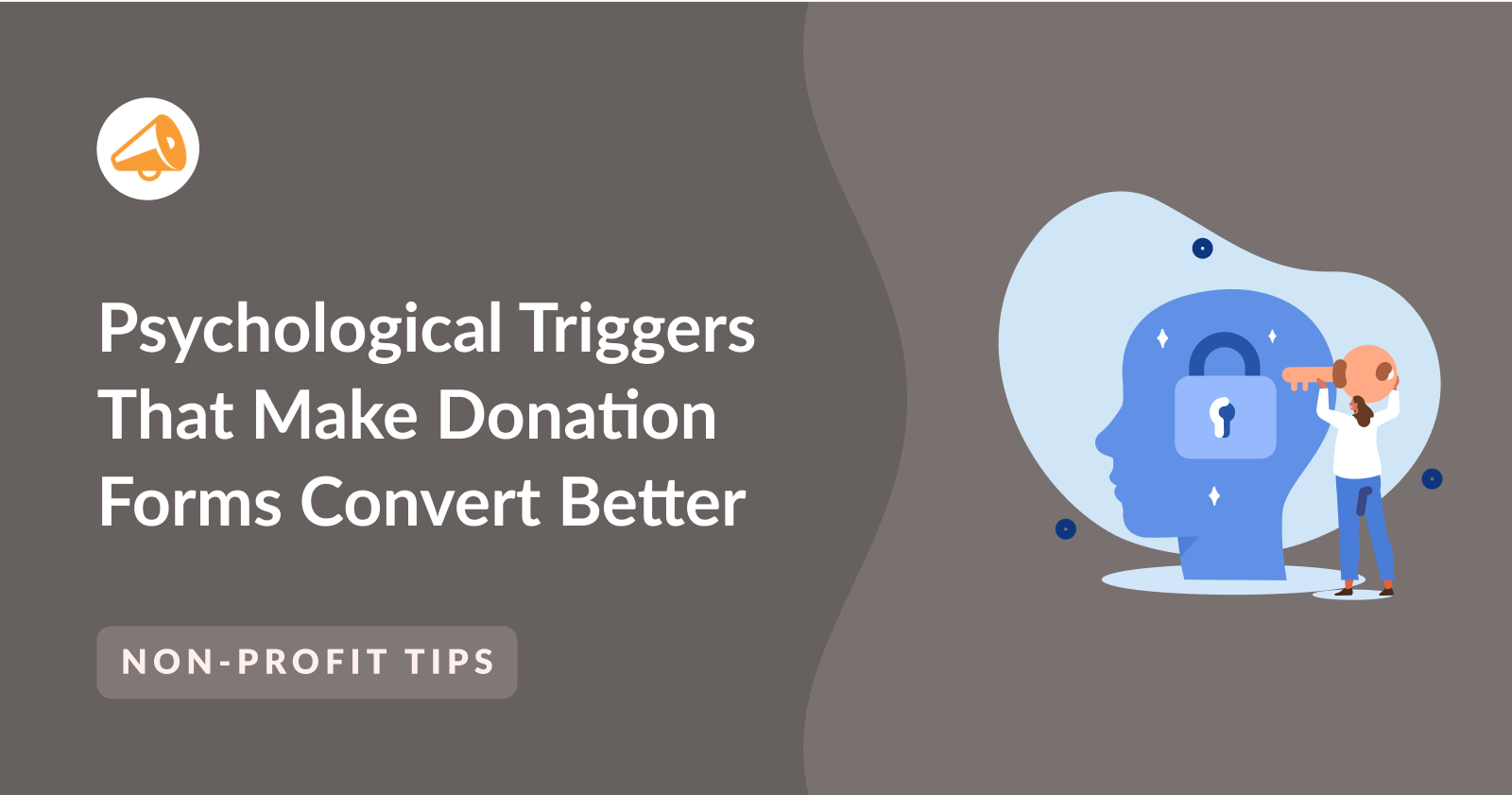



Leave a Reply